With the experience of Quade Cooper and Samu Kerevi back in the starting line-up, the Wallabies were able to pull off a 28-26 upset over the highly fancied Springboks on the Gold Coast on Sunday.
Playing a composed game at 10, Cooper facilitated Wallabies attacks without overplaying his hand and captain Michael Hooper was happy to take the reward of three points when they were on offer. The Wallabies were only able to strike once during the match, through winger Andrew Kellaway, but there were many other chances on offer as the Springboks conceded a considerable number of line breaks to the Australians.
Although the Springboks defence is still very good, the signs were there that they are not operating at the same level as 2019 where line breaks were not allowed at all in general phase play.
During the British and Irish Lions series, and in particular the third test, the Springboks defence was visibly in decline as the Lions found their way through the front line but failed to capitalise on their chances.
Although the Springboks defence is still very good, the signs were there that they are not operating at the same level as 2019 where line breaks were not allowed at all in general phase play. The Wallabies became the latest team to break the Springboks line by willing to chance their arm in attack and find opportunities out wide.
During the sequence leading up to the Wallabies’ first try, this becomes very clear as Sbu Nkosi (14) and Lukhanyo Am (13) uncharacteristically gave the Wallabies plenty of time and space with which to work.
The Wallabies regularly used the threat of a maul throughout their launch plays, forming the maul as ‘bait’ to draw the Springboks pack into the contest before Hooper (7) would break away with the ball.
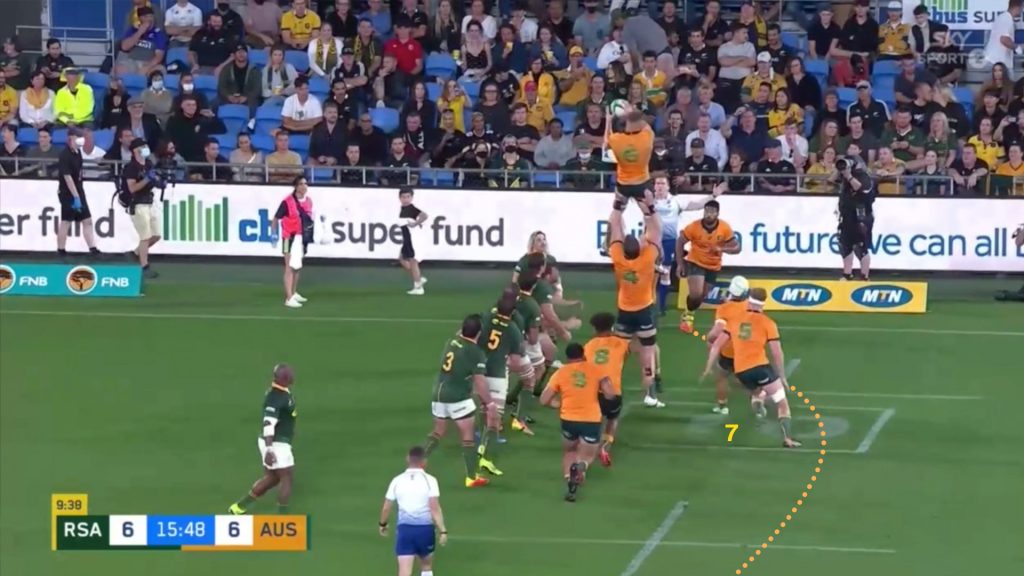
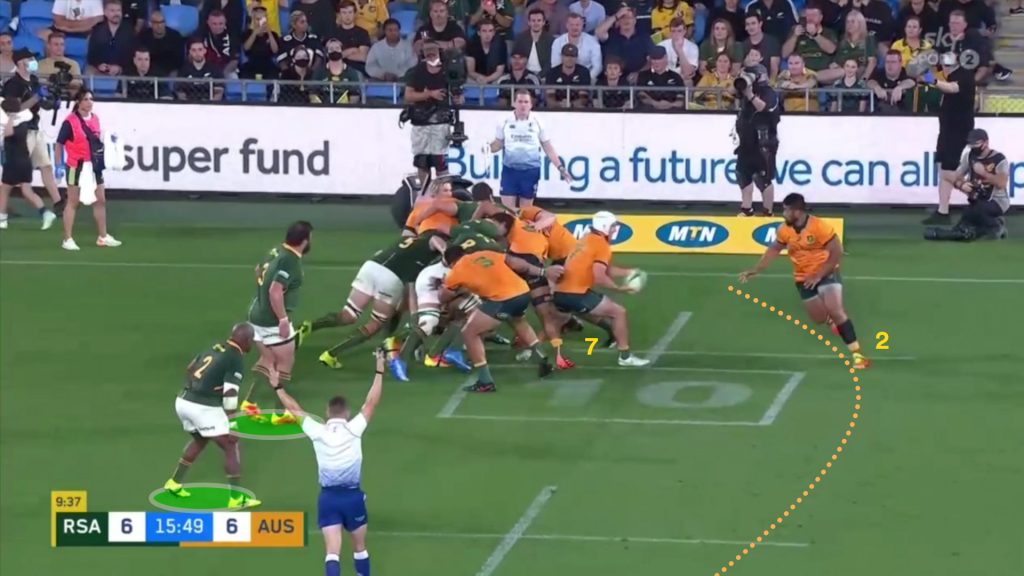
The Springboks did not often compete in the air, but were intent on driving the Wallabies maul towards the touch line. The first Wallaby to bind, Hooper, would then pull out of the maul after the Springboks locks and loose forwards had committed buying the Wallabies more time to hit multi-phase plays.
With Springboks forwards’ heads buried in the maul and potentially heading to the ground, they need that extra second to get back to their feet and reload the line creating delays.
On this first attacking opportunity with Siya Kolisi (6) in the sin bin, the Wallabies create significant territory gain through Samu Kerevi (12) using a variation of the Crusaders wrap play with Folau Fainga’a (2).
The Springbok maul guards, two front-runners, are drawn into contact as Fainga’a puts Kerevi (12) into the seam between the lineout tail and the defending flyhalf as the maul collapses near the touch line.
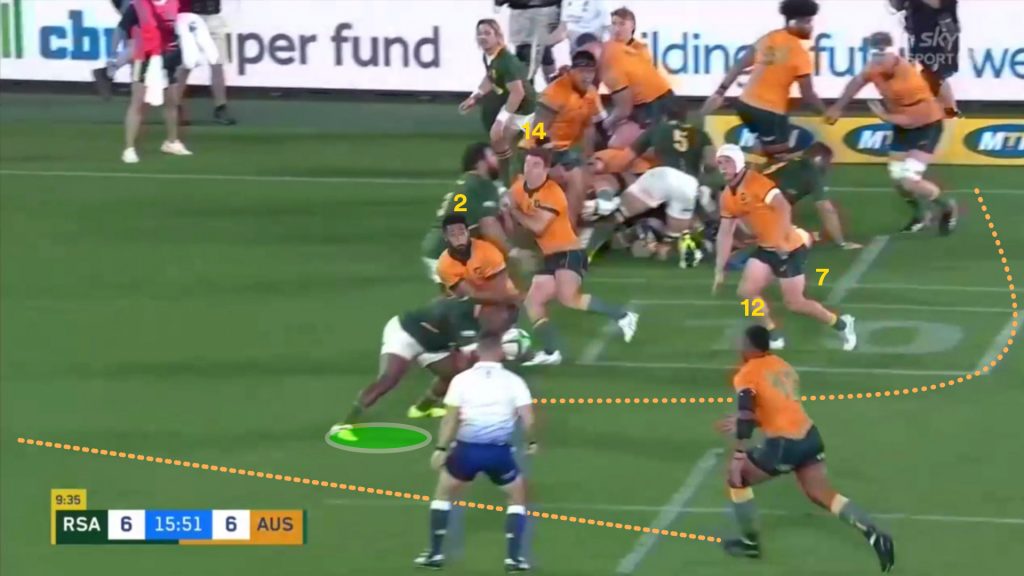

Having succeeded in winning the gain line from the first phase through Kerevi, the Wallabies had a massive opportunity to spin wide immediately where the Springboks edge defence had been thinned out.
The support of forwards coming around the corner is not pressing as they were tied up in the collapsed maul.
Between Am (13) and Nkosi (14) is acres of space and presented a prime opportunity to go wide directly after Kerevi’s carry.

Instead, halfback McDermott played Matt Philip (5) for a carry and the Wallabies lose the opportunity on that side as South Africa have recovered by the next phase.
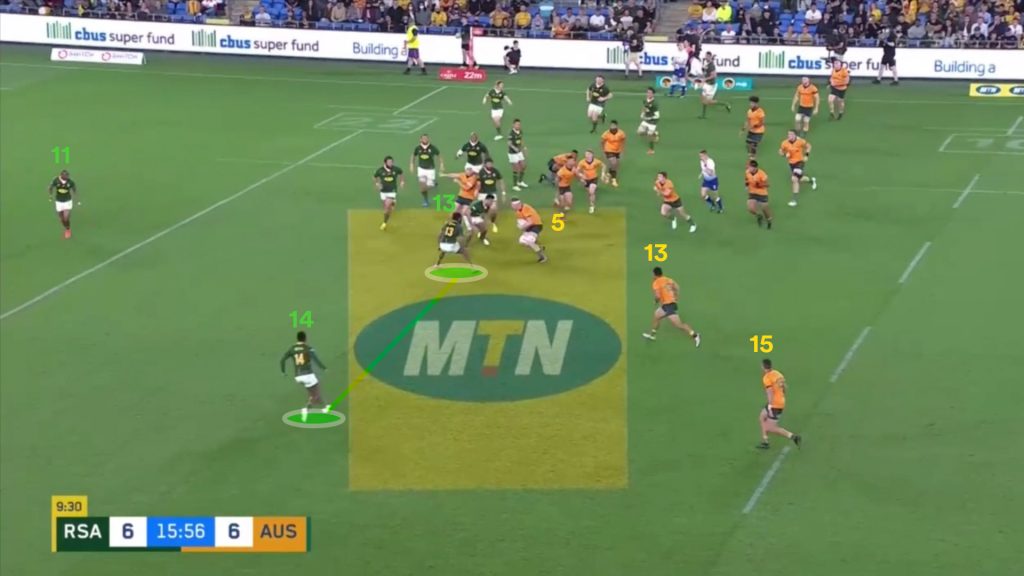
The vast amount of space available to attack on the second phase here is a genuine concern for the Springboks. Despite being a man down in the forwards, the backs are not running the high pressure defensive system anywhere near to the level they were two years ago.
That means danger for the Springboks with the All Blacks approaching in two weeks time. As a team that plays with speed and wants to attack out wide, the All Blacks will not be so forgiving. The Springboks will dearly miss Cheslin Kolbe if he is still not fit and they offer the men in black this kind of space.
The Wallabies themselves will look at the tape and see just how many opportunities they missed in preparation for this weekend’s second clash in Brisbane, but in this sequence they were still able to regroup and find a way through.
After being stopped on the third phase going the same way, the Wallabies work back towards the line out in their standard pattern, playing a carry off 9 before setting up the attack off 10 with a two-man pod outside Cooper.
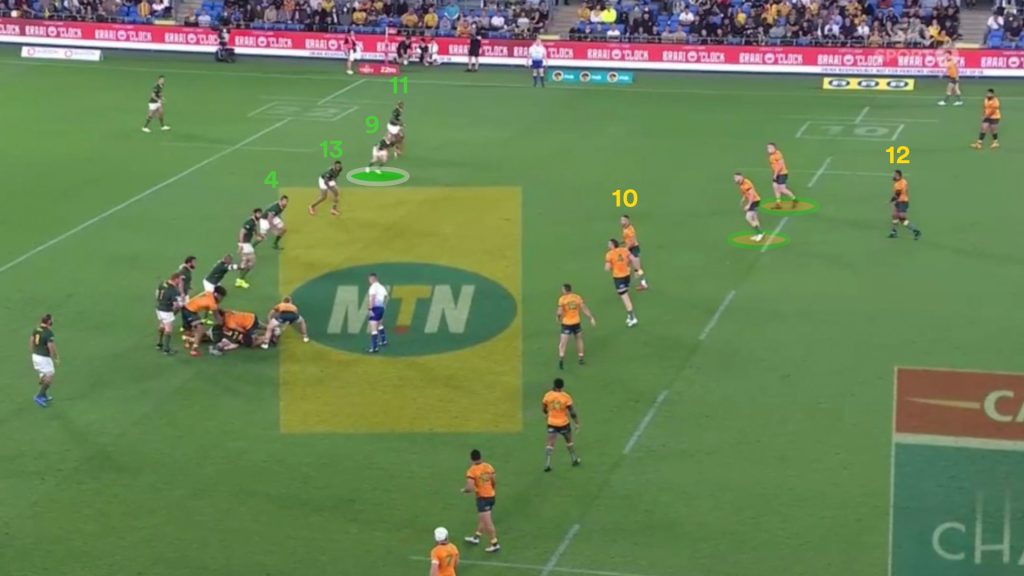
The Springboks have three of their best defenders on the edge, Lukhanyo Am (13), Faf de Klerk (9) and Makazole Mapimpi (11), ready to bring pressure and funnel the play back inside.
The Wallabies play with more depth than usual, asking the Springboks to really come forward out of the line to shut the play down. This level of depth was an effective way to turn the line speed against them on this occasion.
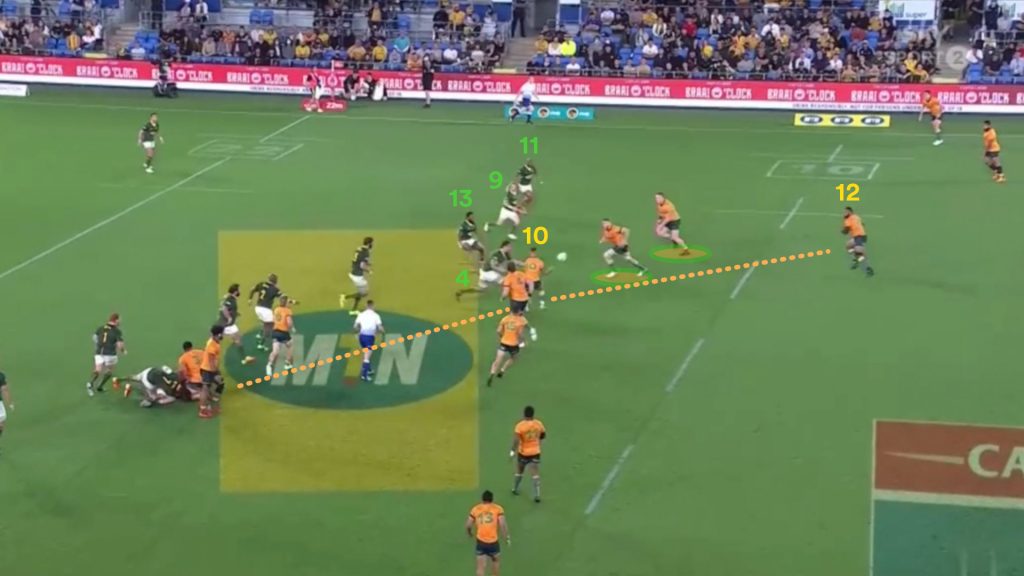
Cooper (10) is hammered by Eben Etzebeth (4) as the pass is fired deep to Kerevi out the back of the two-man pod. The Wallabies midfielder put a giant right foot step on, which is too much for the flying Faf de Klerk.
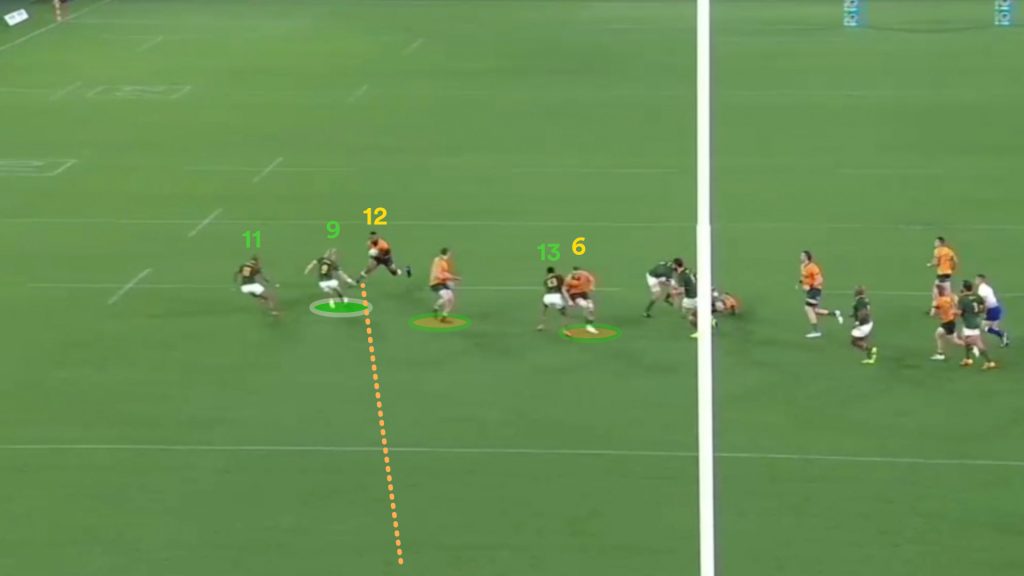
It’s a bad angle by De Klerk (9) and it is made worse by what became a lazy reaction by Am (13).
The Springbok centre is happy to quit on the play after marking Lachlan Swinton’s (6) line, he did not push out as inside cover once Swinton is identified as not receiving the ball. The combination of the two errors opens up a massive gap for Kerevi, who obliges.
The warning sign for South Africa’s defence is De Klerk normally doesn’t take bad angles and Am rarely switches off as he did. These are two of their best defenders that make this system function, so if they can’t perform their roles, the defence is going to break down.
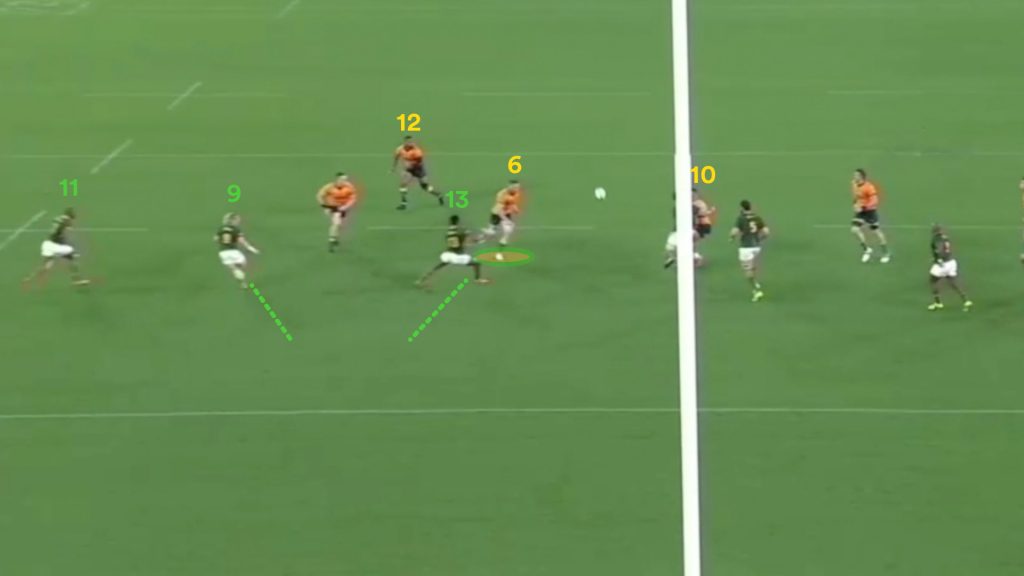
To give Am (13) some benefit of the doubt, the Wallabies put him in a compromised position with the line run by Swinton (6), who adjusted on the fly and ran underneath the centre, combined with a slight head fake from Cooper (10) which drew his interest in the loose forward.
It was perfect execution from the Wallaby duo to draw in Am and create more space for Kerevi and those on the outside.
It was after that where Am didn’t react fast enough to provide inside help for De Klerk. Mapimpi (11) is also not blameless, taking the same man as De Klerk (9), highlighting potential communication issues out wide.
Once Kerevi was through, he linked with Andrew Kellaway (14) who cut back inside to score near the posts and put the Wallabies up 13-6.

To concede a line break to Kerevi and then seven points shows that this once infallible defence is showing more and more cracks as time goes on, from some of their best defenders at that.
Late in the game, the Wallabies use a similar sequence of tactics on an attacking lineout from the five-metre line. They create an opportunity to score despite being the side down to 14 men.
They use the quick maul again, which manages to draw in Lood de Jager (5), before releasing Tate McDermott (9) coming around the corner.
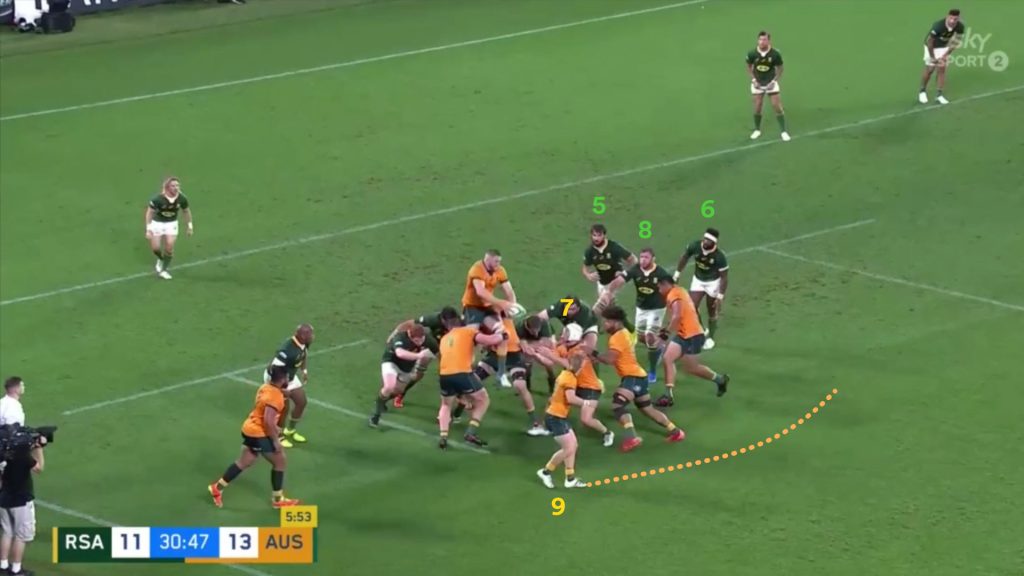
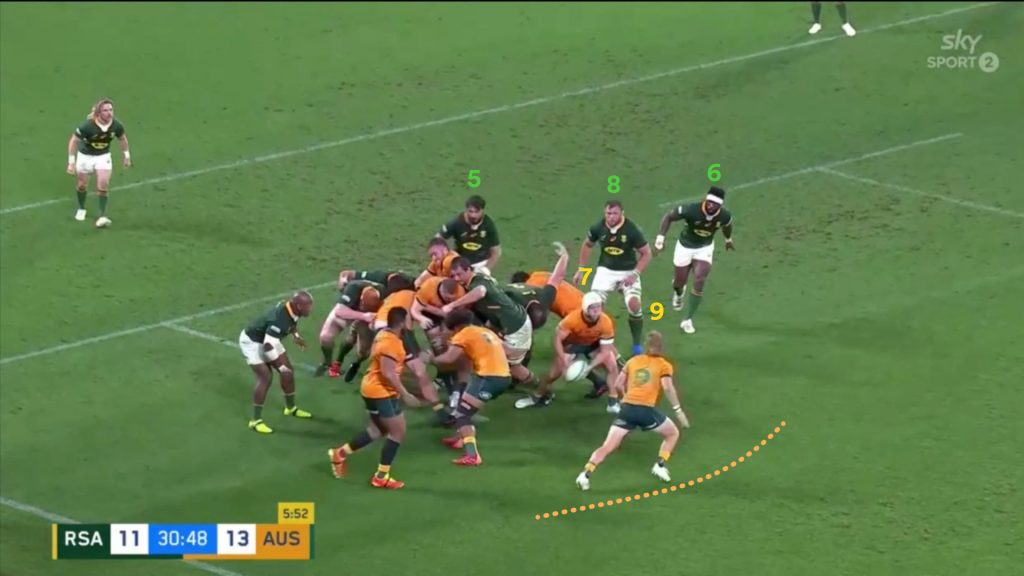
The Wallabies attack the line out seam once more, this time using hard-running winger Marika Koroibete (11) to hit Pollard’s inside channel.
Meanwhile, McDermott has successfully drawn Siya Kolisi (6), the guard and tail defender, into contact to widen the gap for Koroibete to run into.

Koroibete is able to bust his way down to the Springboks’ five-metre line, giving the Wallabies a great attacking platform to work from.
McDermott plays the forward runners around the corner on the next couple of phases in preparation for a strike with a full complement of backs out to the right-hand side.
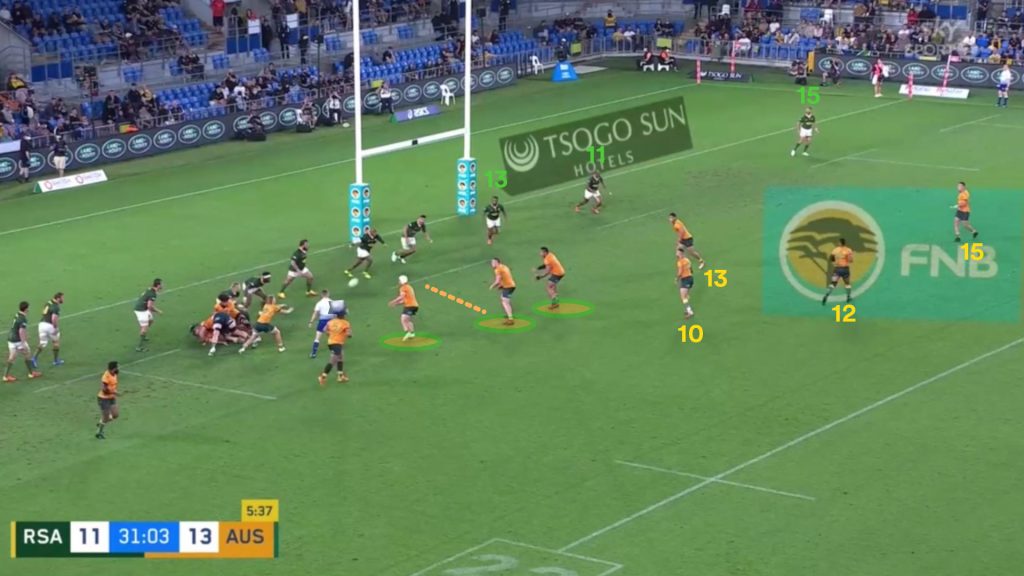
On the backs release, the Wallabies run a simple ‘overs-unders combination with the midfielders, using Len Ikitau (13) running under Mapimpi (11) in order to release Kerevi on the outside running over.
It is noticeable how much time Cooper (10) has, with the edge rush from Am and Mapimpi falling to apply much pressure.
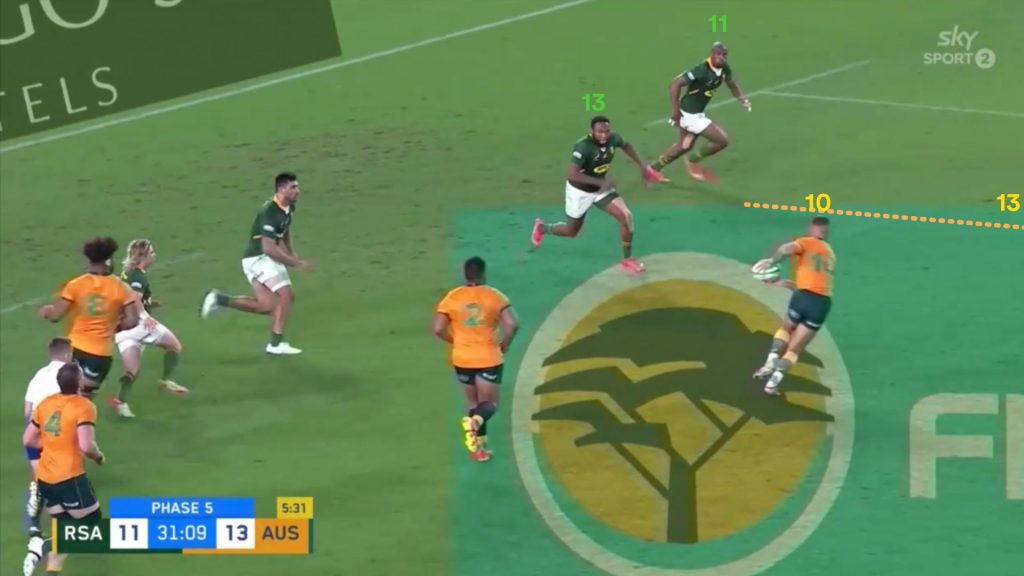
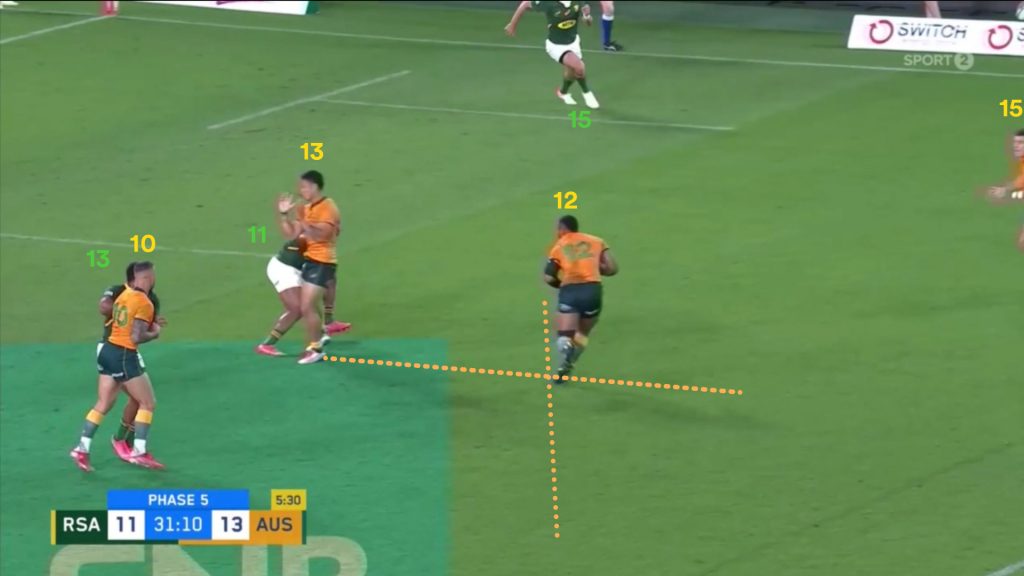
Willie le Roux (15) at the top of the screen is so wide, on the touchline to cover Kellaway leaving a lane for Tom Banks (15).
The Wallabies manufactured a three-on-two which presented a golden opportunity to score from but Kerevi opted for contact instead of drawing and passing.
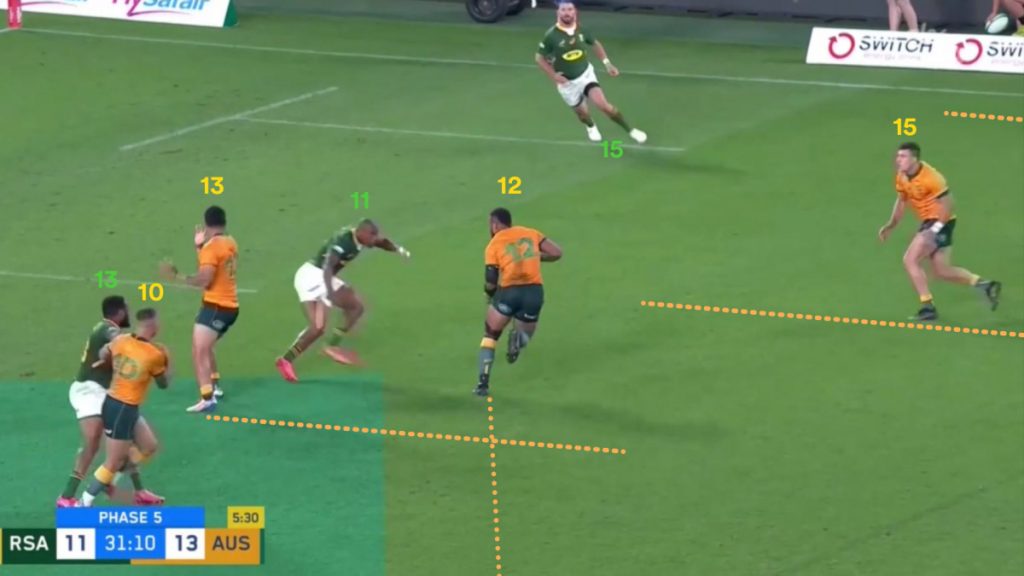
The Wallabies executed this exact same situation multiple times against the All Blacks, using short, sharp passes to utilise the numbers at their advantage.
Tom Banks (15) was able to make the play when under pressure, getting the ball away to Andrew Kellaway for a walk-in try at Eden Park.
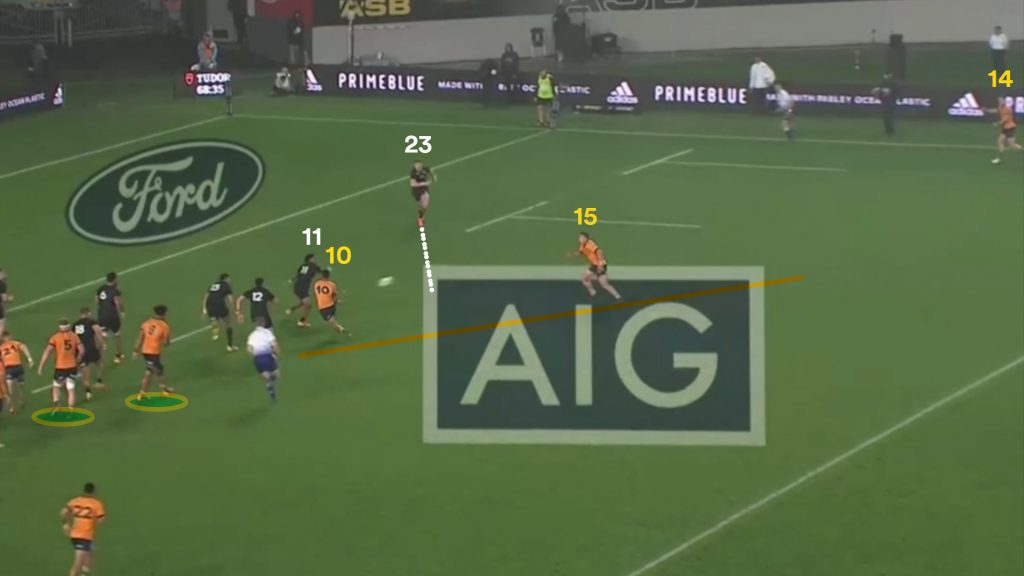
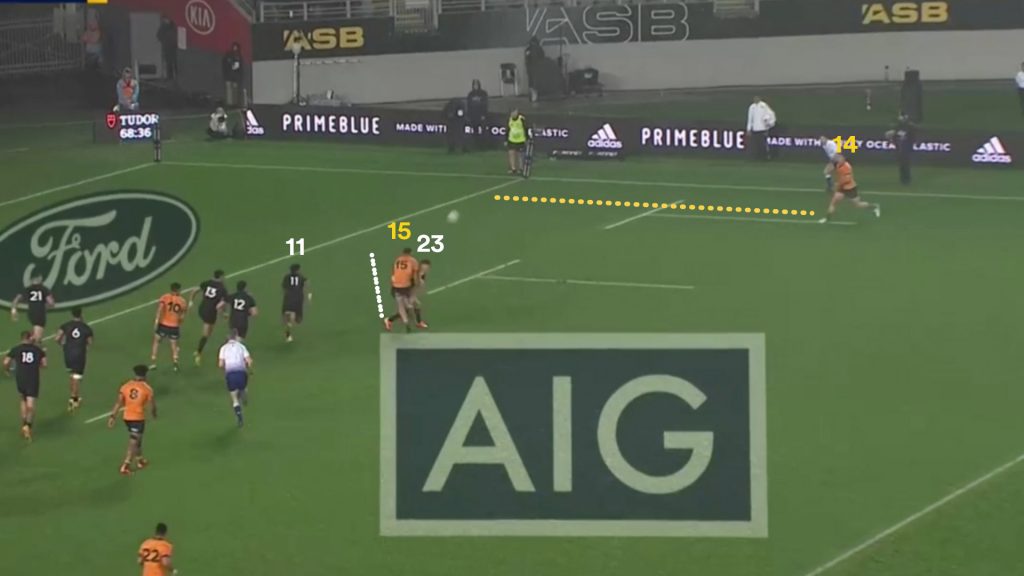
Although Kerevi brings a different power game that was missing at Eden Park, he needs to find balance and make the right call in this situation. There is no doubt a try-scoring opportunity went begging.
Instead of searching for contact and a late offload, a simple draw and pass would have created a two-on-one for Banks and Kellaway on Le Roux, which the Wallabies fullback has proven recently he is capable of finishing.
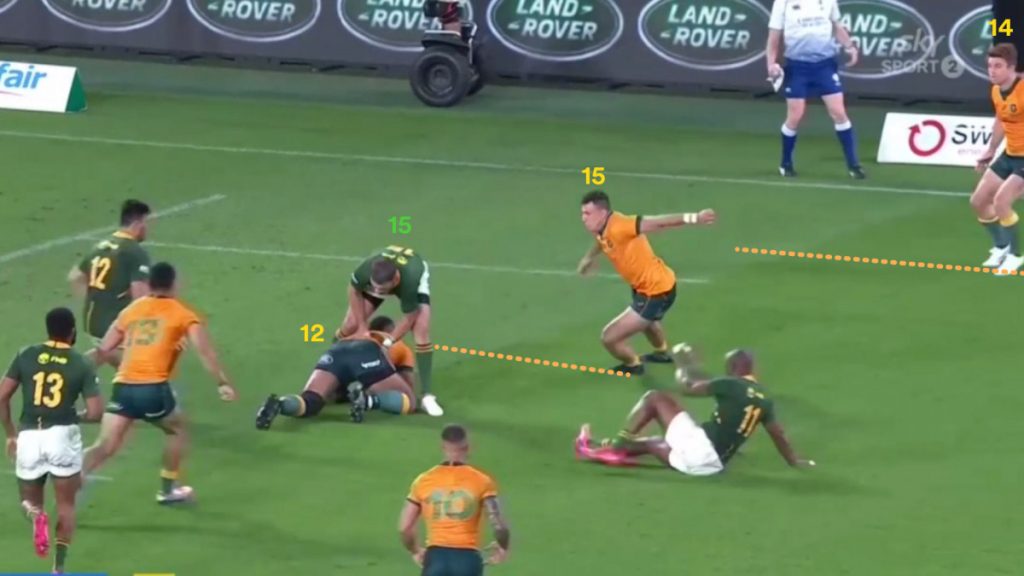
The Wallabies continued to use the quick maul and Hooper’s break to power their lineout launches, and found another line break after using power number 8 Rob Valetini on a crash line a little bit wider targeting Damian de Allende (12).
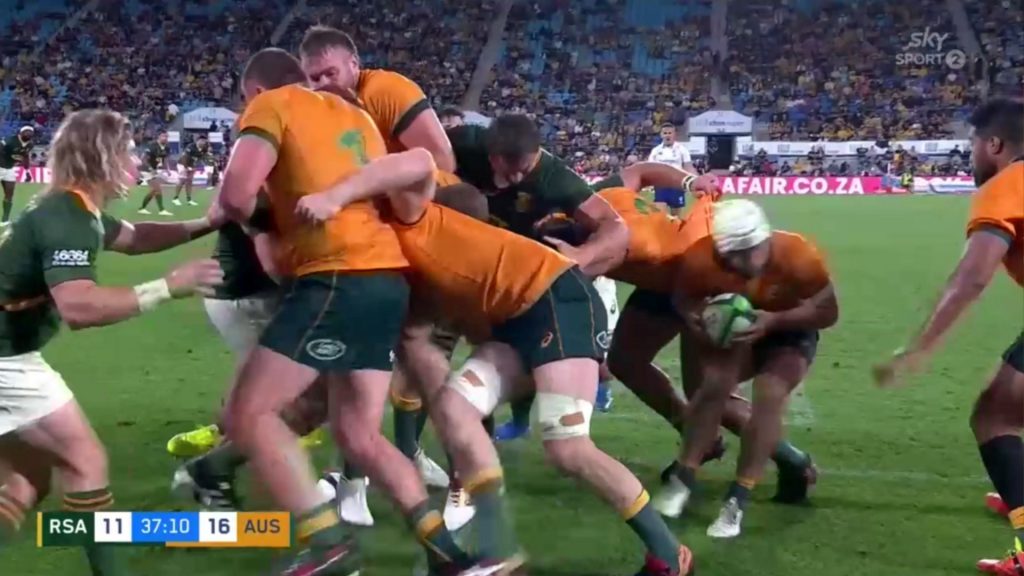
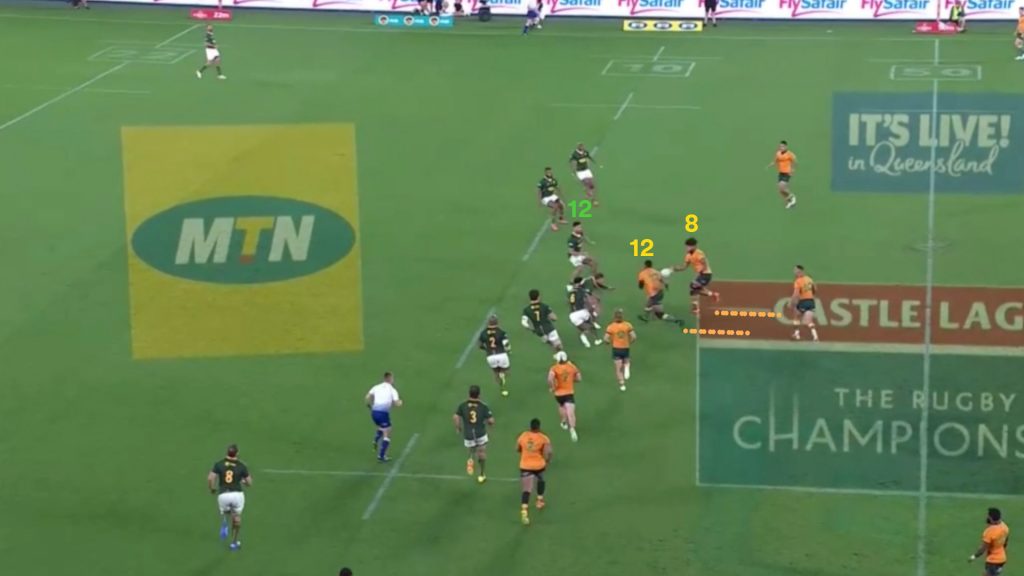
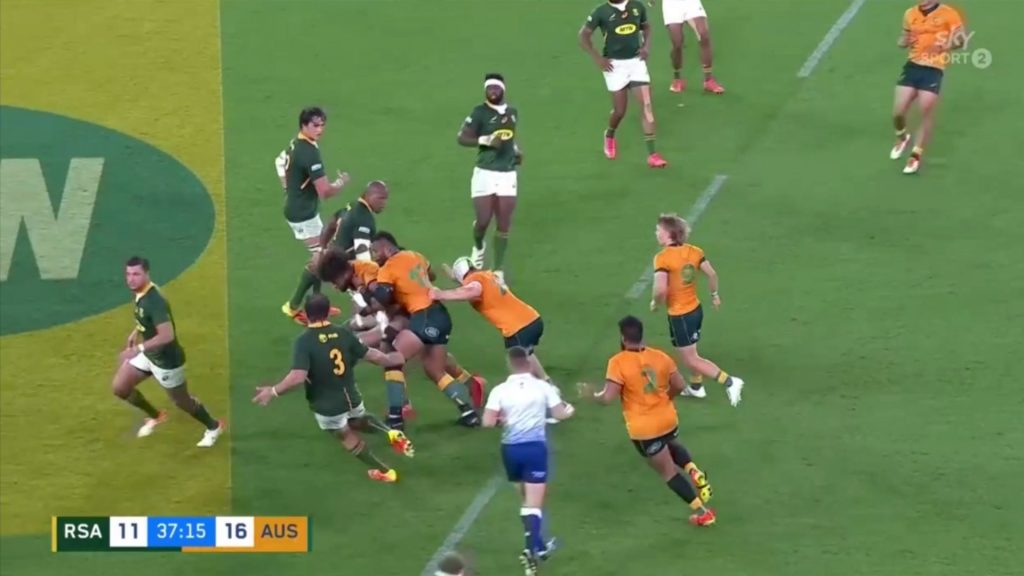
Valetini powers over De Allende with help from Kerevi latching on, and the Wallabies begin to target the Springboks big men around the ruck fringes. Michael Hooper (7) finds a gap after circling back to the ruck and the Wallabies break away downfield.
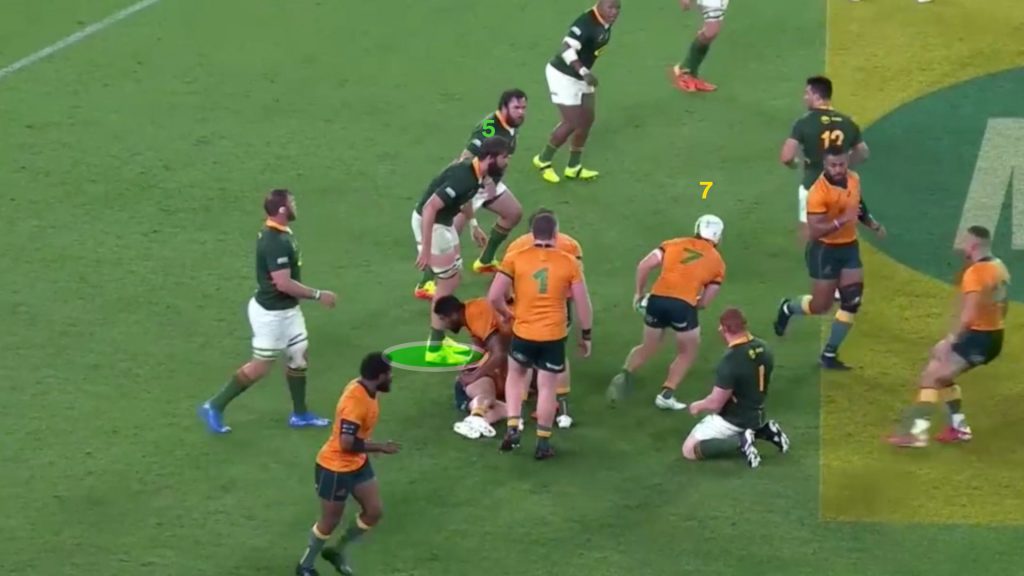
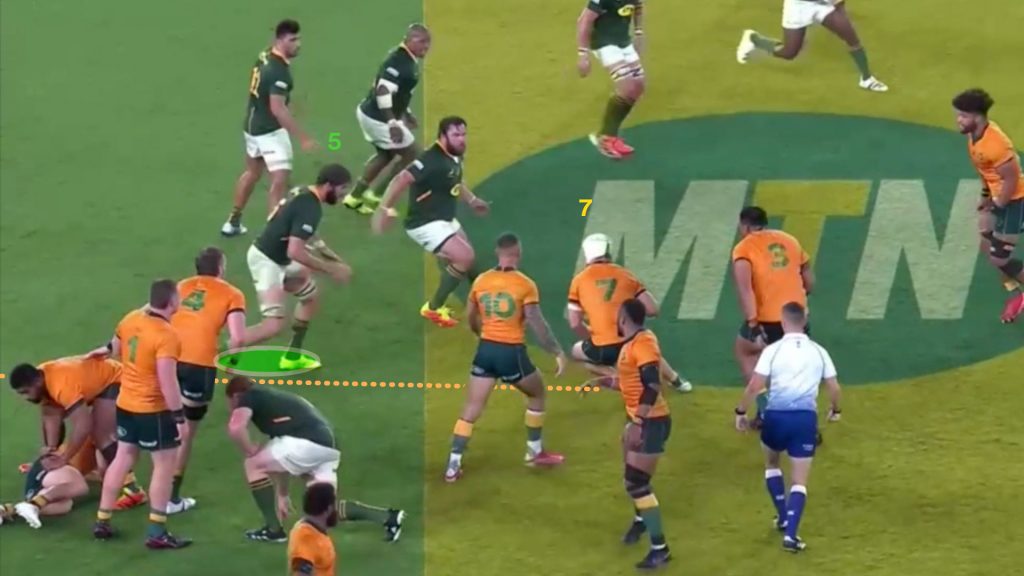
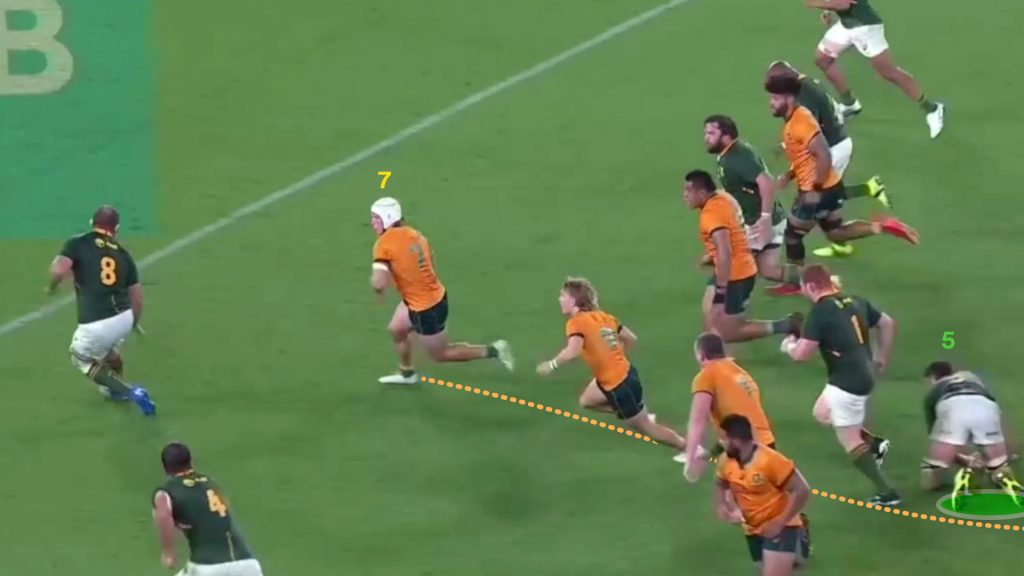
The Wallabies have another opportunity to capitalise on the deep line break by finding width to the left but again it comes unstuck as Kerevi can’t find the touch required to free his outside men.
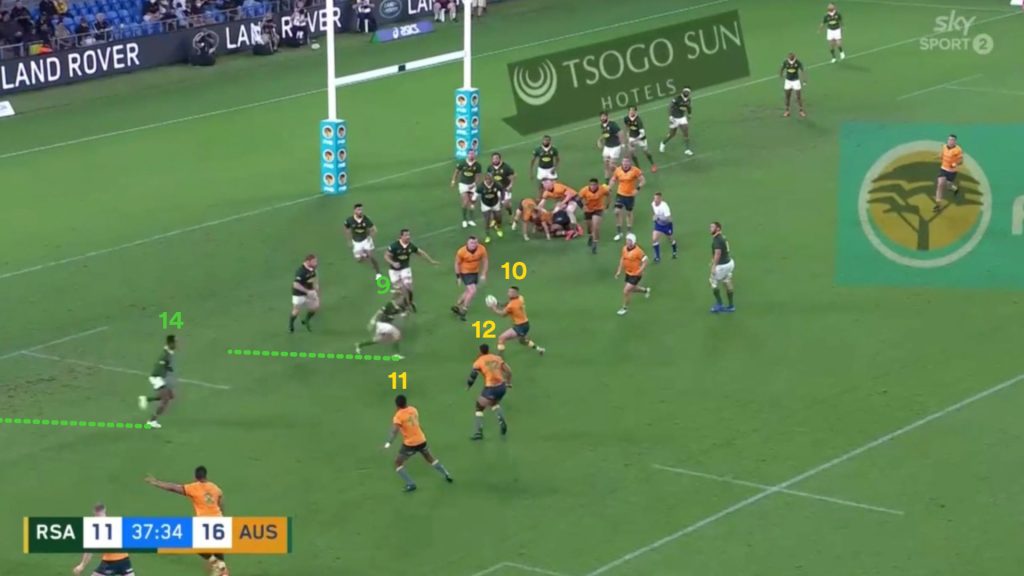
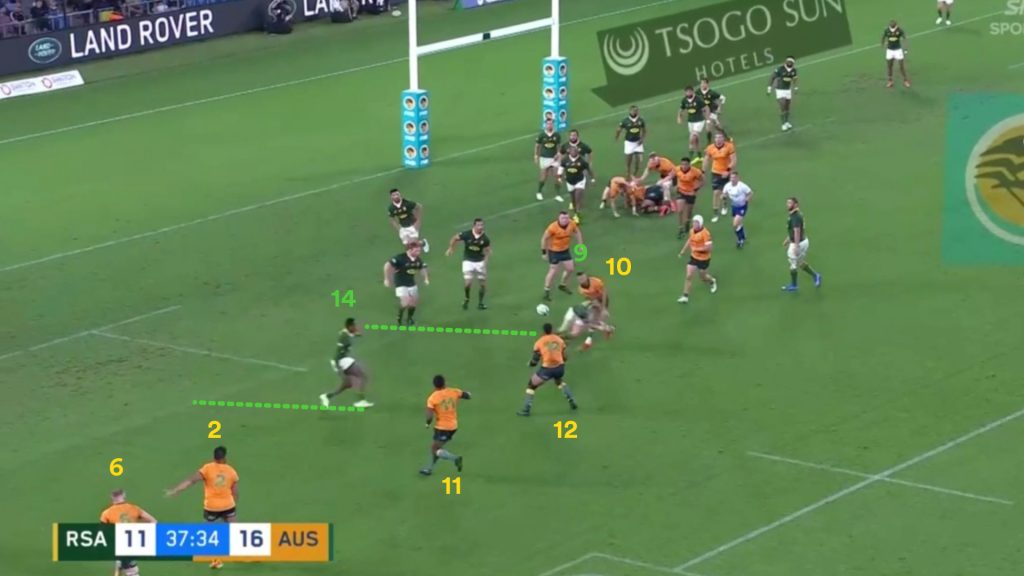
The Springboks rush comes fast but once again cannot stop the ball as Cooper’s quick hands gets the ball to Kerevi, who tries to step inside and then play around the tackle of Nkosi (14).
The Wallabies have three unmarked players in the 15-metre tramlines. If the pass from Kerevi had found its mark, it is highly probable the Wallabies would have scored again.
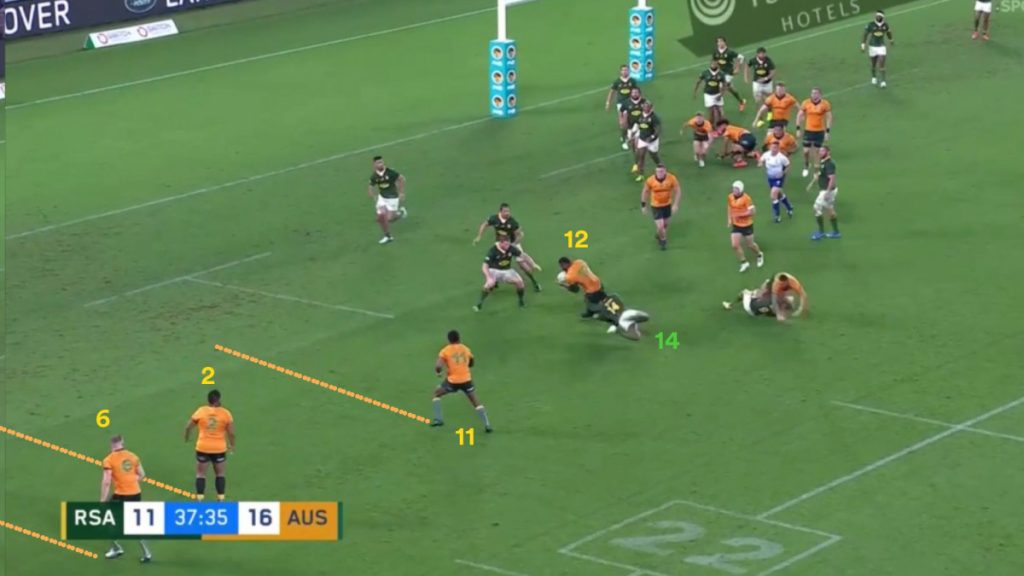
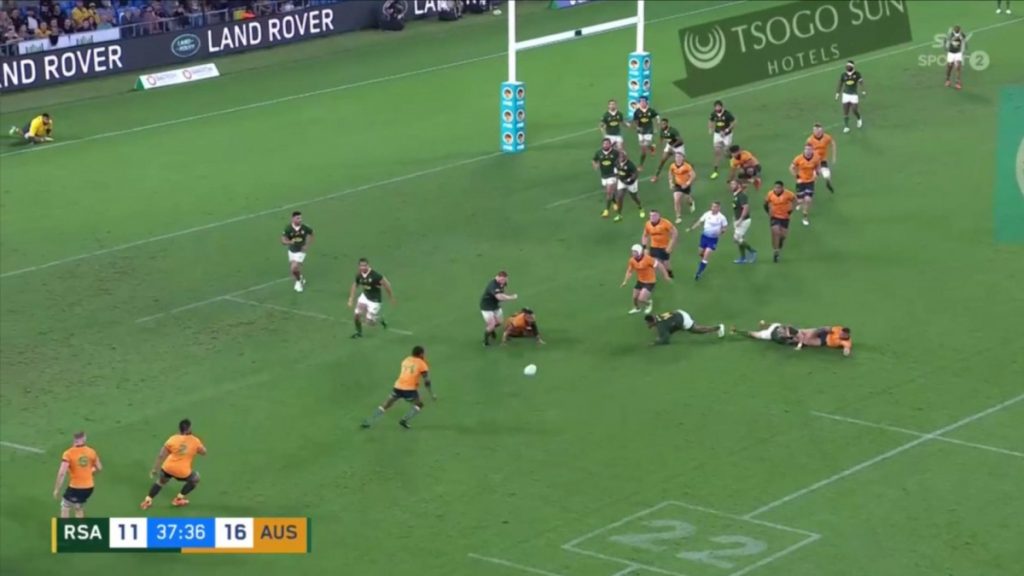
Kerevi may have left these two chances on the table but he was otherwise vital for the Wallabies in laying the platform for the win. He was a handful for the Springboks with carries, often breaking the first up contact and finding the gain line.
The Springboks left points on the field through poor kicking but what is not so obvious is how many the Wallabies left out there too. Had these two highly likely try-scoring chances been taken, the Wallabies are looking at a potential 27-11 lead at halftime instead of 19-11 – a very steep hill to climb for the Springboks in the second half.
The Wallabies continued to create opportunities in the second half as well, with Willie le Roux’s attempted intercept preventing Ikitau from having a chance to score in the corner and Hooper’s break down the left side in the final few minutes another chance gone begging when Willemse makes a great read and tackle on Reece Hodge.
Four to five tries could’ve been had with a higher level of execution and precision, and they only got one.
Overall it was a tired, uninspiring and sloppy defensive performance by their standards from the Springboks who have built their entire game on the defensive prowess that delivered the World Cup.
The illusion was fun while it lasted but this is who the Springboks are – a very good 66 per cent winning team. They won the World Cup with tier one wins over Italy, Wales and England. They scrapped back to win the Lions series on a last-minute Morne Steyn kick.
Historically, the Springboks struggle away from home and you couldn’t get more emphatic proof of that on the weekend in their first away game – losing to the seventh-ranked Wallabies who had been towelled in their last two matches against the All Blacks.
Their second loss of the year, after a run of four straight wins, again leaves questions around whether this side is a force capable of putting together a prolonged period of dominance over tier-one opposition.
That requires turning up each and every week with the same intensity, respecting every opposition and delivering clinical performances. They just failed that.
For whatever reasons, they did not bring their A-game to the Gold Coast. If it always takes random losses to kick the Springboks into gear, then they aren’t going to put together a comprehensive test season to prove they are out-and-out the best team in the world.
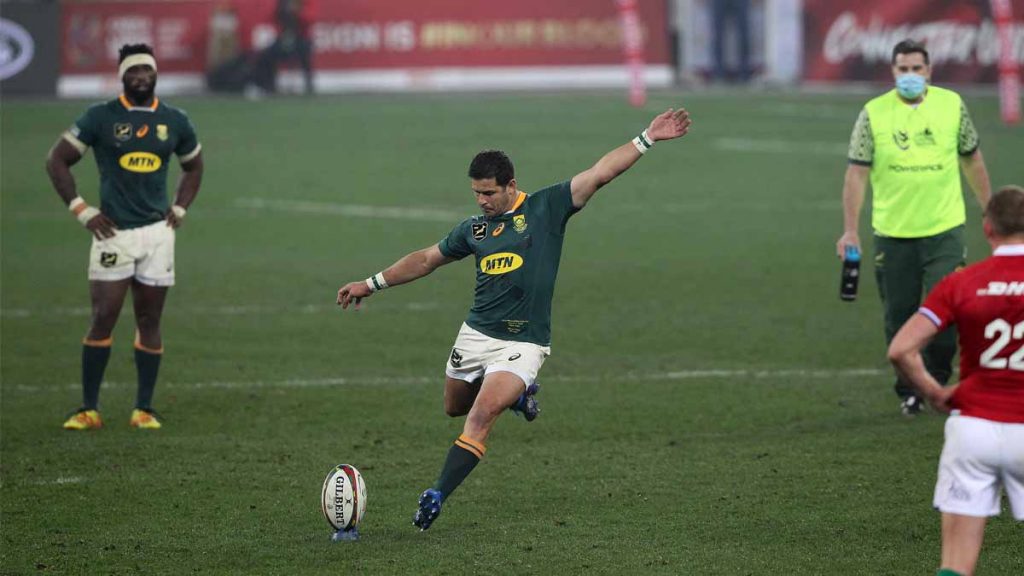
From here it will be a struggle to win the Rugby Championship, realistically needing to win all three remaining games to stay in contention. The ‘prove it’ year is losing credibility fast.
With a 5-2 record to date this year, we could still see a sublime Springboks vintage, but there is little room for error now. They could easily rebound against the Wallabies this week but it is a week too late and a dollar short.
The backs-to-wall mentality that seems to fuel the Springboks will be a powerful driver this week but shows that they aren’t mentally prepared to handle the target of being number one in the first place. If being the underdog is what drives better performances out of them, they aren’t built for being on top of the mountain.
The illusion was fun while it lasted but this is likely who the Springboks are – a very good 66 per cent winning team. They won the World Cup with tier one wins over Italy, Wales and England. They scrapped back to win the Lions series on a last-minute Morne Steyn kick after losing the first test.
They are built to win knockout tournaments and close games which, simulated enough times, won’t always fall your way. Sometimes it works, sometimes it doesn’t. Over a series or short knockout stretch it can work but over a long test season against quality opposition, the jury is out if it can produce domination. The early signs suggest it can’t.
This is a very good team but their run as number one is looking like it is going to be short-lived – at least in terms of games played anyway.


Comments
Join free and tell us what you really think!
Sign up for free